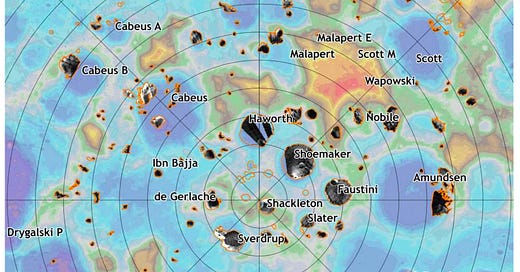Permanently Shadowed Regions

This is an excerpt from Strange Illuminations at the PSRs
The term "Permanently Shadowed Regions" (PSRs) refers to areas on the Moon that never receive direct sunlight due to the low obliquity of the Moon (1.54°). The PSRs at the South Pole are particularly intriguing because they are theorized to contain water ice and are shaded more than those at the North Pole, making them a key focus for research and exploration [2].

Water, a volatile substance on the lunar surface, is especially known to be present and is identified as the most stable compared to other naturally occurring volatiles that might have been released at any point. The quantity of water potentially lost since the lunar surface conditions evolved to the current state is very small.
As a result, the current levels of lunar ice are believed to closely reflect the total amount of water historically present on the lunar surface [4]. Naturally, these regions are of significant interest in planetary science and exploration. The believed water is thought to be trapped in the lunar soil, possibly deposited by impacts from space millions of years ago. This makes them not just important for scientific study but also potential sources of water for future lunar missions. The potential for extracting this ice signifies the importance of studying and exploring PSRs.
Cold Trapping
Cold-trapping is a process where certain regions can trap and freeze volatile substances like water vapor due to their extremely low temperature. Because of the lack of direct sunlight, these PSRs remain cold and have extremely low temperatures. Water sublimation (water to gas) is highly non-linear and slow at low temperatures. Hence, the probability of frozen water.
Temperature (C / K) Area (km²) -163 / 110 3.73 × 10^4 -162 / 111 3.79 × 10^4 -161 / 112 3.86 × 10^4 -160 / 113 3.92 × 10^4 -159 / 114 3.98 × 10^4 -158 / 115 4.04 × 10^4
Seasonal Winter Cold‐Trapping Area in South Polar Region for Threshold Temperatures [6]
Imaging and cataloging PSRs
Imaging PSRs at low illumination conditions is challenging, before the ShadowCam [14], the LRO team utilized the NAC to image PSRs. NAC images were captured using increased exposure times, and to enhance the SNR, the crosstrack-elongated pixels were binned to create a single pixel. Further calibration was performed using lronaccal and lronacecho routines. Ultimately, these images were orthorectified and stretched (2-98%) to create a final PSR NAC product.
All PSRs spanning areas greater than 10 km² have been cataloged in the PSR Atlas [5], each receiving a unique identifier. The atlas currently encompasses 324 PSRs across both the South and North Polar regions. Each PSR is assigned a unique ID; the ID begins with the first two characters indicating the polar region (NP for North Pole or SP for South Pole), followed by the centroid latitude, and then the centroid longitude. The values are delimited by underscores, with the latitude accurate to up to six digits, and the longitude to seven digits.
For eg: SP_871460_0840750
indicates a PSR in the South Pole region with the center 87.146 S, 84.075 E
[1] E. Cisneros, A.K. Boyd, H.M. Brown, A.A. Awumah, A.C. Martin, K.N. Paris, J. Leland, R.Z. Povilaitis, R. Hoppe, L.M. Davis, N.M. Estes, M.S. Robinson, and the LROC Team "Lunar Reconnaissance Orbiter Camera Permanently Shadowed Regions Atlas" July 6, 2018
[2] E. M. Shoemaker, M. S. Robinson, and E. M. Eliason, "The South Pole Region of the Moon as Seen by Clementine," Science, vol. 266, no. 5192, pp. 1851-1854, 1994, doi: 10.1126/science.266.5192.1851.
[3] Goldreich, Peter. "History of the Lunar Orbit". Reviews of Geophysics, Vol 4. November 1966.
[4] Watson, Kenneth M., Bruce C. Murray and Harrison S. Brown. “The behavior of volatiles on the lunar surface.” Journal of Geophysical Research 66 (1961): 3033-3045.
[5] Paul G. Lucey, "The Poles of the Moon",DOI: 10.2113/gselements.5.1.41
[6] Williams, J.‐P., Greenhagen, B. T., Paige, D. A., Schorghofer, N., Sefton‐Nash, E., Hayne, P. O., et al. (2019). "Seasonal polar temperatures on the Moon. Journal of Geophysical Research: Planets, 124, 2505–2521." doi:10.1029/2019JE006028





